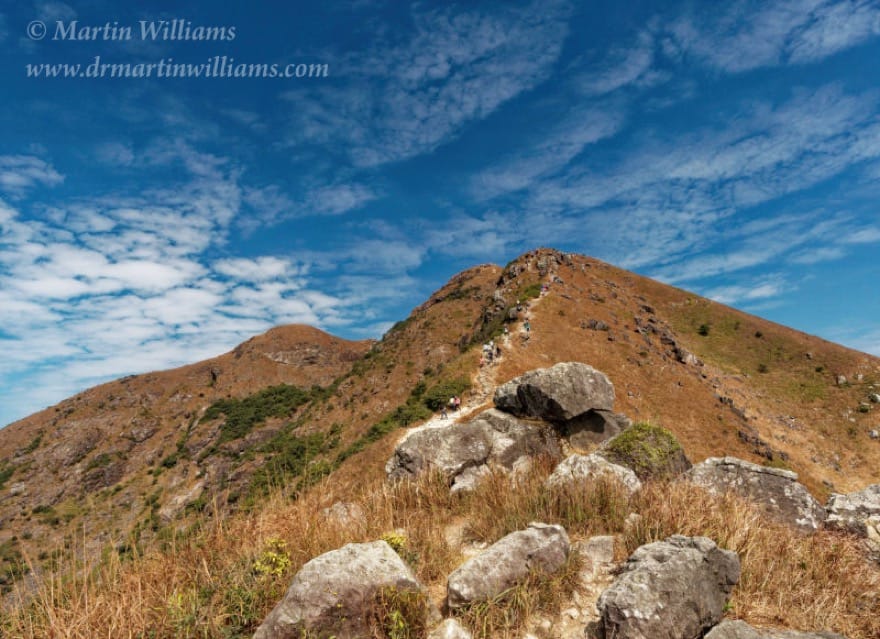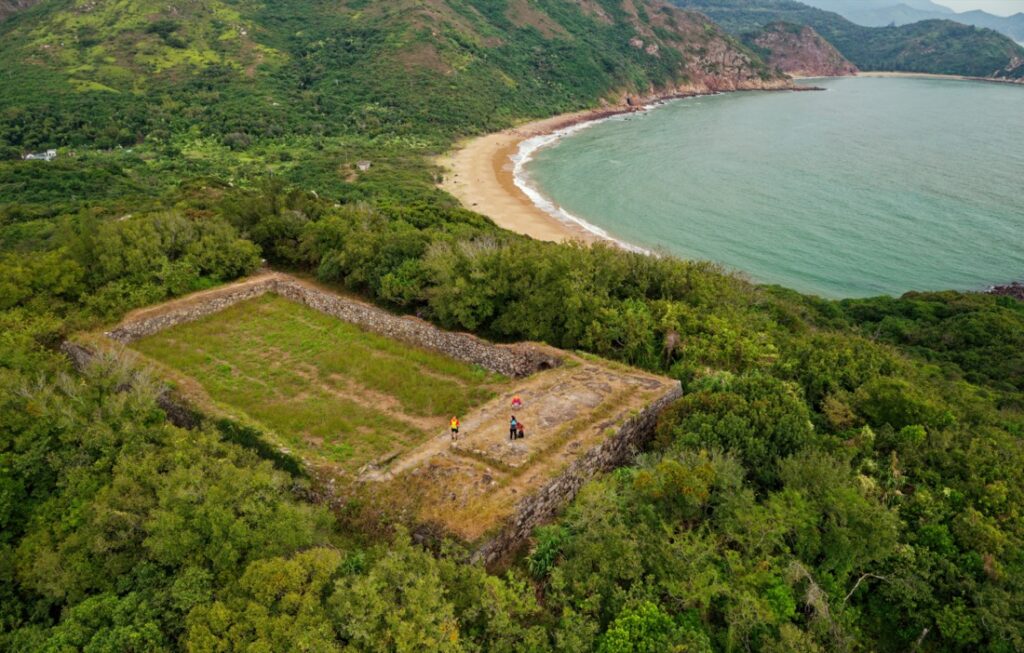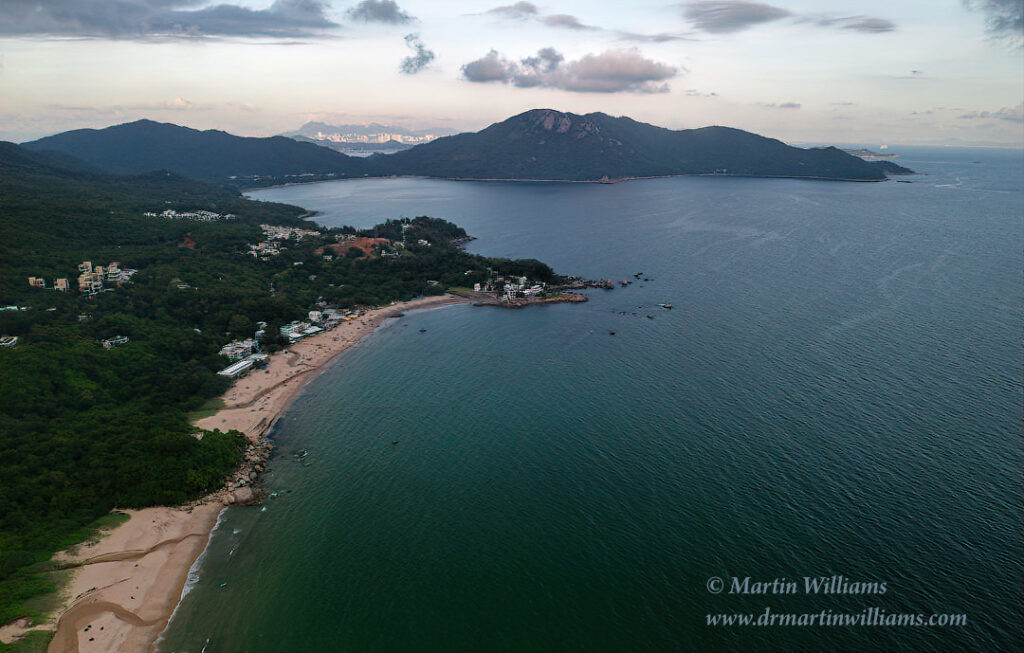Lantau Peak
There’s a steep trail with flights of rough rock steps to the summit of Lantau Peak, at 934 metres Hong Kong’s second highest peak, and highest on Lantau Island. Though you can start at a high plateau reached by bus and cable car, it may take an hour or so of walking up the scrub-covered slopes before you reach the top.

On a clear day, this is a magnificent vantage. Eastwards, across Lantau’s hilly interior, you should see Hong Kong Island. To the west are the Pearl River mouth and Macau. Southwards, islands dot the South China Sea. And beyond the north slopes is Hong Kong International Airport, with a new town on the nearby shoreline. Late one afternoon, I saw “Buddha’s Aureole” here: my shadow appeared to be projected on swirling mist, with a rainbow halo around it.
While I was lucky to see the aureole, most visitors to Hong Kong barely experience Lantau, just touching down at the airport, then being whisked to the city. Or perhaps they visit tourist destinations like Tai O fishing village, the Big Buddha statue, and Disneyland, missing out on what makes Lantau special.
Yet Lantau is Hong Kong’s largest and most beautiful island. Here, you can hike tough hill trails, or stroll along coastal paths, and enjoy wild landscapes, waterfalls, old village areas, beaches, and a surprise or two.
Southwest Lantau
One of these surprises is in the hills of the southwest peninsula. You can reach it by following a section of the Lantau Trail, which is a 70-kilometre hiking route that crosses the island from east to west, including up and over Lantau Peak, and loops back to the starting point. But there’s an easier way, by walking along a narrow, restricted access road beside a catchwater drain, then turning up a track to a low spur.
There are only footpaths from here onwards, and the path now runs through sparse woodland with no sign of any buildings nearby. Yet continue around a corner, and you soon arrive at a Chinese landscaped garden, Lung Tsai Ng Yuen.
This was built in the 1960s, and must have been a grand sight then, featuring carp pond with zigzag bridge, landscaped areas planted with trees, what looks like a guesthouse, and a Chinese style corridor decorated with painted tiles. Sadly, it has become somewhat dilapidated, though the shrubberies are sill maintained, and if you are lucky enough to arrive when the gate is open it’s a pleasure to stroll around Ng Yuen, and relax by the pond.
From here, the path leads to the peninsula’s gently rolling interior. There’s a small temple on a hillside, complete with another oddity: a flying dragon statue atop a boulder.
Climb to the peak beyond the temple, and you are above the coast, in what seems a splendidly remote area. If you only know Hong Kong the metropolis, the sense of freedom and space is surely an even greater surprise than the landscaped garden.

Below lies a headland with the ruins of a Qing Dynasty fort. But though it’s in a scenic place and there’s a path down, maybe keep to the hills and follow a trail that switchbacks along a ridge before dropping to the main south Lantau road.
The best period for hiking Lantau’s hill trails is from around late October to March, when days are cooler and there’s a good chance of dry weather. As the weather warms in spring and early summer, Hong Kong is prone to tropical downpours, though even with these Lantau can make for a rewarding outing.
Mui Wo waterfalls
The rains replenish streams, including one that forms a waterfall just a short walk through the village area at Mui Wo, on Lantau’s east coast. It’s the Silver Mine Waterfall, and is always attractive, with a series of cascades dropping past a pavilion. After heavy rainstorms, it becomes a mighty roaring torrent.
Head higher, along footpaths and then a narrow track, and there’s a lesser-known waterfall, tumbling down a taller rock face. If you clamber up the side you’ll find a vertical water column dropping into a broad plunge pool – a wonderful spot to rest and cool off on a hot day.
Ngong Ping
Heat prevails during the steamy Hong Kong summer, making long hikes challenging and dangerous. There may be a little respite at Ngong Ping, the high plateau by Lantau Peak. Here, throngs of visitors climb steps to the base of the Big Buddha statue, which overlooks a large temple nestled amidst the hills. But you can readily escape the crowds, and enjoy more outstanding views.
There’s a gentle walk to the Wisdom Path, where you can scramble up a low hilltop to admire a reservoir by the sea, and the sharp cone of Lantau Peak. If you’d like a hill walk but Lantau Peak appears too daunting, make for the nearby Nei Lak Shan Country Trail. This five-kilometre route circuits a hill, and you can choose to walk only half way, either walking the north side overlooking the airport, or the southern half of the trail above Ngong Ping. Either way, you finish by cable car and bus stations.
Lowland trails and Lantau surprises

Perhaps choose a bus, and stop at the south coast. Lantau has expansive beaches that are outstanding on late summer afternoons, the best of which is Cheung Sha (Long Sands). There are lifeguards and changing facilities at east and west, and between them you can stroll a shoreline fringed by trees, and marvel at finding such a seemingly out of the way place beside a bus stop in Hong Kong.
Eastwards lies Pui O, a village that’s ramshackle and unappealing along the highway but has rewarding places close by. There’s another beach here, with fine dark sand, plus expansive views of mountains and sea.
Village footpaths cross marshy fields, which are home to feral water buffalo. These are descendants of animals that were abandoned when rice farming became uneconomic, and though huge and powerful, they are well used to people walking by. Left to roam free, they spend much of their time munching on grass and wallowing in mud, and in late afternoons might take a cooling dip in the sea.
Butterflies abound at Pui O. In autumn, hundreds of migratory common tigers – resembling America’s monarchs – gather to feast on nectar of coastal flowers.
There’s another large yet little visited peninsula nearby. Here, too, there is fine hiking, such as along the looping 18.5-kilometre Chi Ma Wan Country Trail. This includes gentle, winding stretches above coastlines and along a boulder-strewn hillside. You can also climb to a craggy summit affording panoramic vistas across south Lantau.
Inland, bulky Sunset Peak dominates the eastern interior of Lantau. It makes for another excellent hill walk, the grassy upper slopes recalling mountains in northern Britain. While if you seek adventure, there’s a gorge slicing into Sunset Peak’s north slopes, where a stream flows along a gentle stretch between by narrow rock walls, before plunging down waterfalls and surging towards a bay by the new town and airport.
The bay, too, is worth exploring, and another trail leads from there to the west coast. What might you find walking here? Well, maybe that will be for you to discover. But always remember: like life, Lantau is full of surprises.
